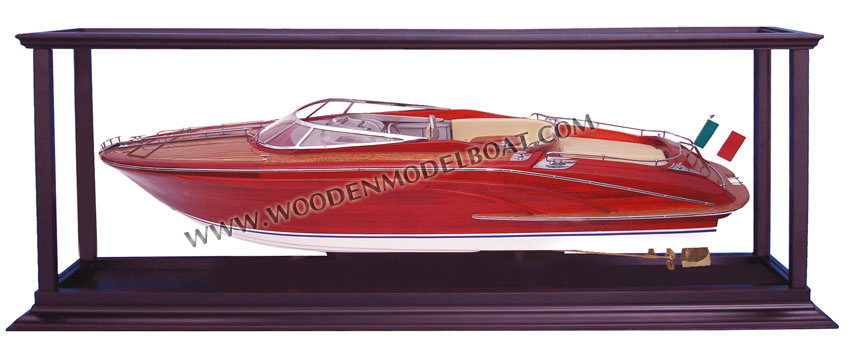By Fred Farley -
Unlimited Hydroplane Historian
One of the most beautiful race boats of all time,
BABY BOOTLEGGER achieved fame as the winner of the
APBA Gold Cup in 1924 and 1925 and the Dodge
Memorial Trophy in 1925.
Designed by George Crouch and built by Henry Nevins,
the construction of BABY BOOTLEGGER was unique. The
sides of the mahogany hull were rounded into the
deck with a gradually changing curve from stem to
stern. The advantage of this design was that it
permitted the construction of a light and strong
hull with a minimum of wind resistance.
The boat initially used a V-8 Hispano-Suiza engine,
specifically the licensed Wright-Hisso version.
Built with 719 cubic inch piston displacement, the
engine was sleeved to meet the 625 cubic inch
maximum of the day. The popular "Hisso" was used in
the Spad aircraft during World War I.
The owner Caleb Bragg was a successful auto racer, a
World War I test pilot, an officer of Wright
Aeronautical, and--by all accounts--a most thorough
engineer.
While never quite the fastest competitor in the APBA
Gold Cup Class of the 1920s, BABY BOOTLEGGER was
very reliable.
A product of the "Gentleman's Runabout" era of power
boat racing, the BOOTLEGGER was a displacement
craft, hydroplane hulls having been outlawed for the
time being by the controversial rule change of 1921.
With owner Bragg at the wheel, BABY BOOTLEGGER (G-5)
posted heat speeds in the 50 mile an hour range.
Bragg and the BOOTLEGGER were involved in one of the
more bizarre chapters in Gold Cup history at the
1924 contest in Detroit.
The Canadian sportsman Harry Greening had apparently
won with his Packard-powered RAINBOW IV, with BABY
BOOTLEGGER coming in second.
But Greening's boat was seen by some as being a
hydroplane rather than a displacement hull. The
craft’s bottom was of lapstrake construction, which
was technically permitted by the rules.
The APBA decided, however, that the strakes had been
installed for the express purpose of achieving a
hydroplane effect. In other words, Greening had
followed the letter of the rules but not the spirit
of them.
As a result, RAINBOW IV was disqualified and BABY
BOOTLEGGER was moved from an overall second to first
position.
Greening never competed for the Gold Cup again,
although he remained active in boat racing affairs
for many years.
BABY BOOTLEGGER may have won the 1924 Gold Cup by
default on a technicality, but she and Caleb Bragg
won the race "for real" in 1925 on Manhasset Bay at
Long Island, New York.
Nine boats showed up to do competitive battle that
year with six of them (including BABY BOOTLEGGER)
using Packard power.
Three 30-mile heats were run and three different
boats won them: NUISANCE, BABY BOOTLEGGER, and MISS
TAMPA.
Heat Two was a heart-stopper. Bragg and BABY
BOOTLEGGER outran Horace Dodge, Jr.'s IMPSHI over
the finish line, 48.462 miles per hour to 48.357.
On the day after Bragg's 1925 Gold Cup win, he
piloted BABY BOOTLEGGER to victory in all four
12-mile heats of the Dodge Memorial Trophy.
Retired from competition, the BOOTLEGGER languished
in storage for many years until discovered in 1977
by vintage boat enthusiast Mark Mason.
Following an accurate, complete, and craftsman-like
restoration by Mason and Bruce Barnard, BABY
BOOTLEGGER was repowered with a rebuilt "Hisso"
engine. It went on to win the Best of Show Awards at
the Antique and Classic Boat Society gatherings in
Clayton, New York, at Lake Winnepesaukee in New
Hampshire, and on Canada's Muskoka Lakes in 1982.
The restored BABY BOOTLEGGER is a fitting tribute to
power boat racing's classic past and one of the few
race boats from the 1920s still in running
condition.













